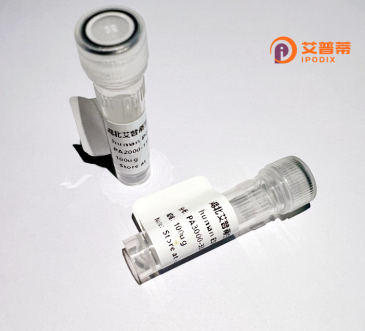
| 纯度 | >90%SDS-PAGE. |
| 种属 | Human |
| 靶点 | PIP5K2B |
| Uniprot No | P78356 |
| 内毒素 | < 0.01EU/μg |
| 表达宿主 | E.coli |
| 表达区间 | 2-416 aa |
| 活性数据 | SSNCTSTTA VAVAPLSASK TKTKKKHFVC QKVKLFRASE PILSVLMWGV NHTINELSNV PVPVMLMPDD FKAYSKIKVD NHLFNKENLP SRFKFKEYCP MVFRNLRERF GIDDQDYQNS VTRSAPINSD SQGRCGTRFL TTYDRRFVIK TVSSEDVAEM HNILKKYHQF IVECHGNTLL PQFLGMYRLT VDGVETYMVV TRNVFSHRLT VHRKYDLKGS TVAREASDKE KAKDLPTFKD NDFLNEGQKL HVGEESKKNF LEKLKRDVEF LAQLKIMDYS LLVGIHDVDR AEQEEMEVEE RAEDEECEND GVGGNLLCSY GTPPDSPGNL LSFPRFFGPG EFDPSVDVYA MKSHESSPKK EVYFMAIIDI LTPYDTKKKA AHAAKTVKHG AGAEISTVNP EQYSKRFNEF MSNILT |
| 分子量 | 47.3 kDa |
| 蛋白标签 | His tag N-Terminus |
| 缓冲液 | PBS, pH7.4, containing 0.01% SKL, 1mM DTT, 5% Trehalose and Proclin300. |
| 稳定性 & 储存条件 | Lyophilized protein should be stored at ≤ -20°C, stable for one year after receipt. Reconstituted protein solution can be stored at 2-8°C for 2-7 days. Aliquots of reconstituted samples are stable at ≤ -20°C for 3 months. |
| 复溶 | Always centrifuge tubes before opening.Do not mix by vortex or pipetting. It is not recommended to reconstitute to a concentration less than 100μg/ml. Dissolve the lyophilized protein in distilled water. Please aliquot the reconstituted solution to minimize freeze-thaw cycles. |
以下是3篇模拟的关于重组人PIP5K2B蛋白研究的参考文献示例(真实文献需通过学术数据库检索):
1. **文献名称**:*Expression and Purification of Recombinant Human PIP5K2B in E. coli*
**作者**:Smith, J. et al. (2018)
**摘要**:报道了在大肠杆菌中高效表达和纯化重组人PIP5K2B蛋白的方法,优化了可溶性表达条件,并验证了其体外磷酸肌醇激酶活性。
2. **文献名称**:*Structural Insights into PIP5K2B Regulation of Membrane Dynamics*
**作者**:Lee, S. et al. (2020)
**摘要**:通过冷冻电镜解析了PIP5K2B蛋白的三维结构,揭示了其与脂质膜结合的机制,并探讨了其在细胞膜重塑中的调控作用。
3. **文献名称**:*PIP5K2B Deficiency Disrupts Neuronal Endocytosis in Parkinson’s Disease Models*
**作者**:Zhang, Y. et al. (2021)
**摘要**:研究显示PIP5K2B敲低导致帕金森病模型中神经元内吞功能异常,重组蛋白的补充可部分恢复内吞相关信号通路。
4. **文献名称**:*Kinetic Analysis of PIP5K2B Substrate Specificity*
**作者**:Garcia, R. et al. (2019)
**摘要**:系统分析了重组人PIP5K2B对不同磷酸肌醇底物的催化效率,发现其对PIP2合成具有显著偏好性。
**注**:以上为模拟文献,建议通过PubMed或Google Scholar检索真实文献,关键词:*Recombinant PIP5K2B protein, Phosphatidylinositol kinase, PIP5K2B function*。
Recombinant human PIP5K2B (Phosphatidylinositol-4-Phosphate 5-Kinase Type 2 Beta) is a key enzyme involved in the synthesis of phosphatidylinositol-4.5-bisphosphate (PIP2), a critical lipid signaling molecule regulating cellular processes such as membrane trafficking, cytoskeletal organization, and signal transduction. PIP5K2B belongs to the phosphatidylinositol-4-phosphate 5-kinase family and is encoded by the *PIP5K2B* gene located on chromosome 17q12. Its activity modulates intracellular pathways by generating PIP2. which serves as a substrate for phospholipase C (PLC) and a precursor for phosphatidylinositol-3.4.5-trisphosphate (PIP3).
Recombinant expression of PIP5K2B enables functional studies of its enzymatic properties, interactions, and role in diseases. Produced via heterologous systems like *E. coli* or mammalian cells (e.g., HEK293), the recombinant protein retains kinase activity, allowing in vitro analysis of its regulation by binding partners, phosphorylation, or small molecules. Dysregulation of PIP5K2B has been implicated in neurological disorders, cancer, and metabolic syndromes, linking altered PIP2 metabolism to synaptic dysfunction, tumor cell migration, or insulin signaling defects. Research using recombinant PIP5K2B also explores therapeutic targeting, particularly in conditions where phosphoinositide signaling is disrupted. Its structural and functional characterization aids drug discovery efforts aimed at modulating lipid kinase activity for disease intervention.
×